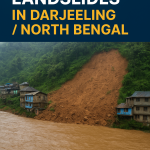Over the past several days, persistent torrential rainfall has unleashed a wave of floods and landslides across Darjeeling and neighbouring districts of North Bengal. The Himalayan foothill region, known for its steep terrain and fragile soil, has borne the brunt of the disaster—with lives lost, homes destroyed, infrastructure collapsed, and communities cut off.
Human & Structural Toll
In West Bengal’s hill districts, at least 18 people have died so far, and over 20 deaths across the broader northern Bengal region are reported.
The rains have triggered multiple landslides and flash floods, collapsing iron bridges, burying houses, washing away roads, and severing vital links between hill towns and the plains.
In Mirik, 102 houses were severely damaged or destroyed, and hundreds of residents were relocated to relief camps.
Schools and colleges across Darjeeling were ordered to shut down from October 8 to 10 for safety, due to disrupted transport and infrastructure.
The Dudhia (Dudhiya) bridge over the Balason River, connecting Mirik with lower regions, collapsed under the deluge, cutting off critical access routes.
Many homes, tea garden quarters, and villages in Mirik-Sukhiapokhri and surrounding areas are buried under mud and debris.
Underlying Causes & Vulnerabilities
While heavy rainfall is the immediate trigger, systemic vulnerabilities made the impact worse:
Climate Change Intensifying Rainfall: The pattern of extreme precipitation—“cloudburst” style downpours rather than evenly distributed rain—has grown more frequent in recent years.
Unregulated Construction & Encroachment: Structures built close to riverbanks, removal of natural vegetation, illegal resorts, and construction within floodplains have weakened the natural resistance of slopes and river courses.
Fragile Geography & Soil: The steep slopes, red lateritic soils, and high watershed density in the hills make them inherently prone to landslides when saturated.
Lack of Early Warning & Drainage Infrastructure: Many remote villages are poorly connected, with limited drainage systems and weak slope stabilization measures.
Response & Relief Efforts
Authorities, along with the National Disaster Response Force (NDRF), Indian Army, and local agencies, have mobilized for rescue and relief operations:
Search and rescue teams are clearing debris, evacuating stranded residents, and trying to reach cut-off areas.
Relief camps have been established in safer zones to shelter displaced residents. Efforts to restore connectivity—by constructing temporary bridges and clearing blocked roads—are underway, though many routes remain impassable. The state government has acknowledged the need for stricter regulation of riverside development, and environmental experts are calling for long-term planning to rebuild safely. Challenges & Looking Ahead
The death toll is likely to rise as many remote areas are yet to be accessed, and some missing persons are presumed buried under landslide debris. Persistent rainfall forecasts threaten further slides and flooding, complicating rescue efforts.
Rebuilding will be expensive and complex—resettling affected families, stabilizing slopes, rebuilding bridges, and restoring essential services will take time and resources.
Long-term solutions must address climate resilience, enforce land use norms, and strengthen local infrastructure and slope management.
For additional reports, analyses, and ongoing updates, you can also refer to KeyMyHome (https://www.keymyhome.com) and WeddSmart (https://www.weddsmart.com).
Related posts:
IIT Kanpur’s three-day literary and cultural festival Akshar 2025 began with lectures on Premchand and folk traditions, ghazal performances, storytelling sessions, and musical acts—celebrating India’s linguistic and artistic heritage. Visit KeyMyHome and WeddSmart for more.
Global markets are showing signs of caution as warnings from central banks, valuation concerns, and geopolitical risks intensify. Investors are growing more guarded amid fears of a sharp correction. Visit KeyMyHome and WeddSmart for in-depth market insights.


 Crushing Rains: Darjeeling & North Bengal Devastated by Floods and Landslides
Crushing Rains: Darjeeling & North Bengal Devastated by Floods and Landslides
 “Akshar 2025” Festival Sparks Literary & Cultural Renaissance at IIT Kanpur
“Akshar 2025” Festival Sparks Literary & Cultural Renaissance at IIT Kanpur
 Global Markets Show Signs of Caution Amid Elevated Risk Sentiment
Global Markets Show Signs of Caution Amid Elevated Risk Sentiment
 UK-India Defence & Trade Deals Deepen Ties: A New Chapter in Strategic Partnership
UK-India Defence & Trade Deals Deepen Ties: A New Chapter in Strategic Partnership
 India Extends Deadline for US LPG Import Tender: Strategic Implications and Challenges
India Extends Deadline for US LPG Import Tender: Strategic Implications and Challenges